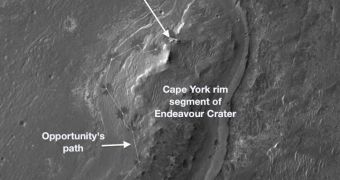As winter on the Red Planet prepares to descend over Opportunity's current location, mission managers at the NASA Jet Propulsion Laboratory (JPL), are continuously planning how to use the rover without draining it of its energy. A solution would be for the machine to analyze the planet's interior.
Such studies have never been conducted before, primarily because the JPL team has always kept the Mars Exploration Rover (MER) moving. It now lies on an outcrop at the rim of Endeavour Crater, and it took it more than three years of continuous driving to get here.
Opportunity will celebrate its 8th anniversary since arriving on our neighboring planet later in January. Originally destined to survive for just 90 days, both it and its twin MER Spirit managed to endure for way longer than that. Spirit, unfortunately, had to be abandoned in 2010, due to technical issues.
But Opportunity carried on, and even received software upgrades that now allow it to scan its surroundings autonomously, and make decisions about which rock to sample all on its own. However, with winter nearly upon it, it needs to keep still in a position where it gets enough sunlight.
There are two ways for a robotic explorer on the Martian surface to go about exploring the planet's underground. It can either use a big drill to dig deep beneath the surface – something that Opportunity is incapable of doing – or it can stand perfectly still, and simply beam radio signals back to Earth.
According to JPL MER project manager John Callas, scientists could get “a handle on the structure of the interior of the planet – the distribution of mass, and perhaps how large the core might be.” This would tell us a lot about the Red Planet's ancient history.
Knowing more about the Martian interior could help us figure out whether or not it was ever capable of supporting life, as well as reveal more clues about how the early solar system looked like.
Astronomers estimate that acquiring the data needed to figure out whether the Martian interior is dead or not could be collected in 3 to 6 months of non-stop observations. Opportunity would have to remain perfectly still throughout this period, Space reports.
The JPL team admits that it would have enjoyed continuing to conduct geological surveys with the rover, but says that a thick layer of dust covering Opportunity's panels would make this way too risky.
If, by fortuitous accident, a wind gust or sand storm clears the rover's panels, then it's possible that the JPL group will change its mind, and reassign the machine to its real duties.

 14 DAY TRIAL //
14 DAY TRIAL //